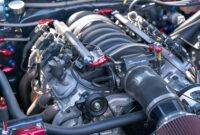Struts are an essential part of a car’s suspension system. They are responsible for supporting the weight of the car and damping the oscillations of the springs. Struts are typically made of steel or aluminum and are filled with hydraulic fluid.
How Do Struts Work?
Struts work by transferring the force of the springs to the chassis of the car. The hydraulic fluid inside the strut helps to dampen the oscillations of the springs and prevents the car from bouncing excessively.
Struts are typically mounted to the chassis of the car at the top and to the control arm or knuckle at the bottom. The upper mount is typically a ball joint, which allows the strut to pivot as the suspension moves. The lower mount is typically a rubber bushing, which isolates the strut from the chassis and prevents noise and vibration.
Types of Struts
There are several different types of struts, including:
- MacPherson struts: MacPherson struts are the most common type of strut. They are used in a wide variety of vehicles, including cars, trucks, and SUVs. MacPherson struts are typically mounted to the chassis of the car at the top and to the control arm at the bottom.
- Coil-over struts: Coil-over struts are similar to MacPherson struts, but they have a coil spring mounted on the outside of the strut. Coil-over struts are often used in performance vehicles because they allow for a more precise adjustment of the suspension.
- Air struts: Air struts are filled with air instead of hydraulic fluid. Air struts can be inflated or deflated to adjust the ride height of the car. Air struts are often used in luxury vehicles and SUVs.
Benefits of Struts
Struts offer a number of benefits over other types of suspension systems, including:
- Reduced weight: Struts are lighter than other types of suspension systems, which can help to improve fuel economy.
- Improved handling: Struts help to control the movement of the suspension, which can improve handling and stability.
- Reduced noise and vibration: The hydraulic fluid inside the strut helps to dampen noise and vibration, which can make for a more comfortable ride.
Signs of Worn Struts
Struts can wear out over time, and it is important to be aware of the signs of worn struts. Some of the signs of worn struts include:
- Leaking hydraulic fluid: If you see hydraulic fluid leaking from the strut, it is a sign that the strut is worn and needs to be replaced.
- Clunking noises: If you hear clunking noises coming from the suspension, it could be a sign that the struts are worn and need to be replaced.
- Excessive bouncing: If your car bounces excessively, it could be a sign that the struts are worn and need to be replaced.
- Uneven tire wear: If your tires are wearing unevenly, it could be a sign that the struts are worn and need to be replaced.
Strut Replacement
If the struts on your car are worn, it is important to have them replaced as soon as possible. Worn struts can lead to a number of problems, including reduced handling, increased noise and vibration, and uneven tire wear.
Strut replacement is a relatively straightforward procedure that can be performed by most mechanics. However, it is important to note that strut replacement can be dangerous if it is not done properly. If you are not comfortable replacing struts yourself, it is best to have the work done by a qualified mechanic.
Conclusion
Struts are an essential part of a car’s suspension system. They are responsible for supporting the weight of the car and damping the oscillations of the springs. Struts offer a number of benefits over other types of suspension systems, including reduced weight, improved handling, and reduced noise and vibration. If the struts on your car are worn, it is important to have them replaced as soon as possible to avoid potential problems.




